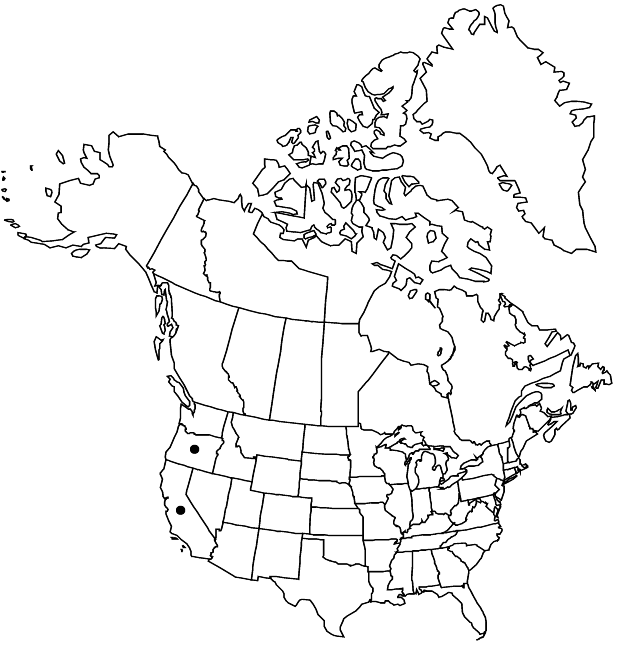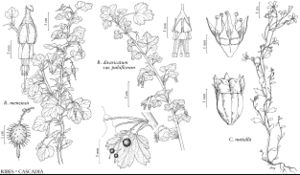Ribes menziesii
Fl. Amer. Sept. 2: 732. 1813 ,.
Plants 1–2 m. Stems erect, pubescent, glandular-bristly; spines at nodes mostly 3, 10–15(–20) mm; prickles on internodes dense. Leaves: petiole 1–2.5 cm, pubescent, stipitate-glandular; blade broadly ovate, 3–5-lobed, cleft less than 1/2 to midrib, 1.5–2.5 cm, base semitruncate or slightly cordate, surfaces abaxially pubescent and sessile- or stipitate-glandular, adaxially glabrous or sparsely pubescent, lobes cuneate-rounded, margins crenate-dentate, apex rounded. Inflorescences pendent, solitary flowers or 2-flowered racemes, 2–4 cm, axis short-pubescent, glandular. Pedicels not jointed, 3–6 mm, pubescent, stipitate-glandular; bracts broadly ovate, 3–5 mm, pubescent, stipitate-glandular. Flowers: hypanthium crimson, conic, 2.5–3.5 mm (1/4–1/3 as long as sepals), white-pilose, with red, stalked glands and red bristles; sepals not overlapping, reflexed, reddish purple or greenish purple, oblong-lanceolate, 7–11 mm; petals connivent, erect, white or pinkish to yellow, broadly flabellate-cuneate, often with inrolled margins, 3–4 mm; nectary disc not prominent; stamens 1.5–1.8 times as long as petals; filaments linear, 3–5 mm, glabrous; anthers white or tan, lanceolate-sagittate, 2.5 mm, apex acute, mucronate; ovary somewhat pubescent and strongly purplish glandular-bristly with longer glandless bristles among gland-tipped hairs; styles connate to middle, 6–8 mm, glabrous. Berries not palatable, reddish purple, ellipsoid-globose, 10–13 mm, pubescent, glandular-bristly.
Phenology: Flowering Feb–May.
Habitat: Ravines, wooded canyon slopes
Elevation: 0-1800 m
Distribution

Calif., Oreg.
Discussion
Varieties of Ribes menziesii that have been recognized in the past include: var. hystrix, which occurs in the inner South Coast Ranges, is not particularly aromatic, has leaves glandular abaxially, filament lengths equal to the petals, and berries with glandular and nonglandular hairs; var. ixoderme, which occurs in the Sierra Nevada foothills, is aromatic, has leaves glandular abaxially, filament lengths longer than petals, and berries with glandular and nonglandular hairs; var. leptosmum, which occurs in the outer North Coast Ranges and San Francisco Bay area, is not particularly fragrant, has filament lengths longer than petals, and berries densely covered with gland-tipped bristles and without nonglandular hairs; var. senile, which occurs in the southwestern part of the San Francisco Bay area, is not particularly fragrant, has leaves with relatively few glands abaxially, filament lengths 1.5 times the petals, and berries with dense, soft, white hairs and gland-tipped bristles. M. R. Mesler and J. O. Sawyer Jr. (1993) concluded that the differences are not sufficient for recognizing these taxa.
Selected References
None.
